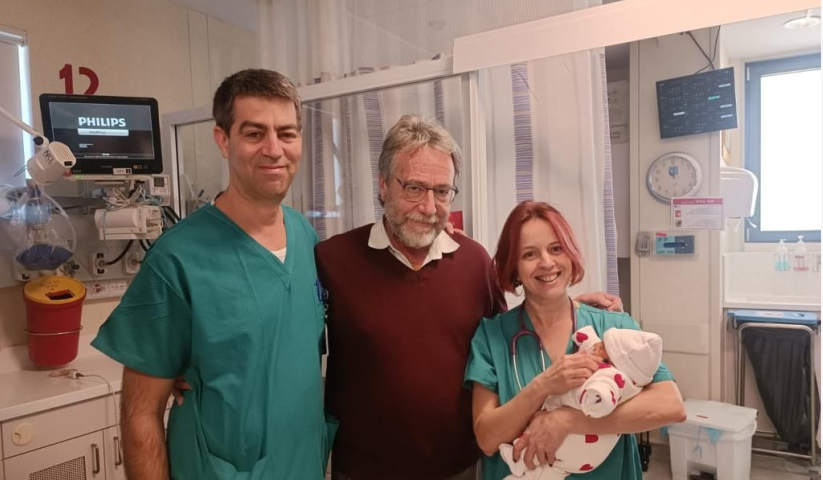Surgeons at Hadassah-University Medical Center in Jerusalem’s Ein Kerem have treated an extremely rare case of ovarian torsion on both sides in a baby girl right after her birth.
When Tamar Levy came for a routine checkup when at 35 weeks gestation, she didn’t imagine the drama that was about to take place and certainly did not think that 30 minutes after the birth of her daughter, she would already be successfully operated on at the hospital.
“I came for a routine ultrasound examination in a community clinic before the birth, and the technician identified something abnormal in the abdominal cavity of my fetus, but she did not know exactly what it was. After consulting with my gynecologist Dr. Mark Zerah, we were quickly sent to Hadassah’s emergency room. It was very stressful. I came with my own mother, and we couldn’t really understand what was happening.”
An uncommon but serious condition called ovarian torsion (also known as adnexal torsion) occurs when the ovary and sometimes the fallopian tube twists on the tissues that support them. This cuts off the blood supply to the ovary, which if not treated promptly, can cause tissue in the organ to die.
While generally rare, the condition is most commonly seen in reproductive-aged women, and girls from nine to 14 years old are at greatest risk due to the flexibility of the tissue in their young reproductive systems. Ovarian torsion is the most common complication of an untreated ovarian cyst. It is an emergency that must be treated as quickly as possible to protect ovarian functioning.
Finding ovarian torsion in newborn babies
In newborn baby girls, ovarian torsion may be asymptomatic. In children over a year of age, ovarian torsion comprises 1.3% of acute surgical diagnoses. The detection of fetal ovarian cysts (FOCs) detected in utero has risen in recent years due to the availability and prevalent use of ultrasound. FOCs are usually seen towards the end of the second trimester during a routine prenatal ultrasound. Stimulation of the fetal ovary by placental and maternal hormones leads to the development of ovarian cysts. They tend to regress shortly after birth once the hormonal stimulation has decreased, but complications such as hemorrhage, rupture, and torsion can develop.
A bilateral ovarian cyst is an extremely rare case; it’s described in the medical literature a few times, while in fetuses it is not hardly documented.
The symptoms of a twisted ovary arise suddenly and intensely in girls and women and include severe pain in the pelvic region, nausea and vomiting.
Surgery is the only way to treat ovarian torsion. If there is a cyst, the doctor will first remove it, and then untwist the ovary and/or fallopian tube, which will restore proper blood flow.
When she arrived at the hospital, she first met Dr. Shay Porat of Hadassah’s obstetrics and gynecology department. performed an in-depth ultrasound exam in which he explained her fetus suffered from cysts in both ovaries, and possibly also from bilateral ovarian torsion – a condition that can cause the loss of both ovaries. He stressed that every second that passes could lead to a devastating result.
“I prayed that it wouldn’t be too late,” Levy recalled. “These were very stressful moments, but Dr. Porat did everything in a pleasant manner and made me feel that everything was under control.”
The ovaries are the “ovum factory” where the female hormones estrogen and progesterone function. In the absence of ovaries, that patient would not be able to have children on her own and would need an egg donation from another woman. In addition, she would need hormone replacement therapy for many years to preserve the health of her bones, blood vessels, and reproductive system.
It’s usually very difficult to identify the ovarian environment in fetuses, said Porat, “but there are signs that help us make the diagnosis more accurate. Thanks to the upgrade of the ultrasound device at our hospital just a few weeks before, we could clearly see in the test performed on the fetus that there was still blood flow to her ovaries, but the flow was slow. I knew we had to act quickly so as not to lose the ovaries,” he said.
He immediately contacted Dr. Dan Arbel, director of the pediatric oncology surgery unit, and Dr. Noa Ofek Shloma’i, director of the premature and newborn unit at the medical center. After consultation, it was quickly decided to deliver the baby immediately and rush the newborn to surgery.
Operations on newborns, especially premature babies, are challenging, and even surgery that is seemingly easy to perform on an adult requires great skill when it comes to a preemie,” noted Arbel. “We were able to operate in record time – half an hour after her birth she was inside the incubator in the neonatal intensive care unit. During the operation, we did indeed find two ovaries that were twisted, and they quickly recovered after the blockage in the blood vessels was loosened and the cysts were drained. All of this was made possible thanks to the neonatal intensive care team led by Dr. Ofek-Shloma’i, because without anesthesia and monitoring throughout the operation, it would have been impossible to perform it.”
“Thank God, everything went well, said the motion. “I thank everyone who took care of me and for the wonderful and quick work done by the staff at the hospital to save our daughter.”


